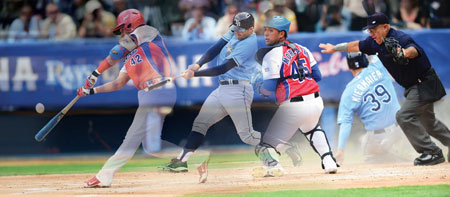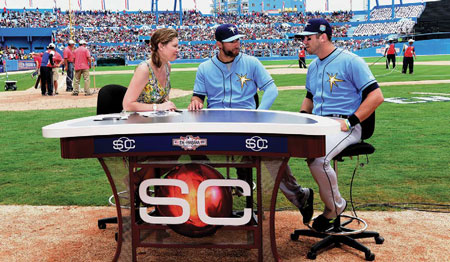¡Pléibol!

HAVANA— This was a happening.
True, this happening was just an exhibition baseball game; yet, it was history.
Major League Baseball teams have rarely played in Communist Cuba—the last game from “The Pearl of the Antilles” was played on March 28, 1999, between the Baltimore Orioles and the Cuban National Team, and broadcast by ESPN.
The network was also on hand on Tuesday, March 22, 2016, when the Tampa Bay Rays squared off against the Cuban National Team, with the presidents of the United States and Cuba in attendance.
This was not a normal broadcast from Havana or from its 60-year-old Estadio Latinoamericano baseball stadium; but not only did ESPN and ABC News make it work, they produced numerous news reports with pre- and post-game programming, and were able to share some resources while doing so.
BIDING TIME
About two months ago, ABC News and ESPN conferred about coverage of President Barack Obama’s goodwill trip, including the game, according to Brian Kennedy, vice president of newsgathering operations for ABC News, “because we knew we could share shipping and resources,” including a generator, lights, platforms and accessories, like tents, phones and Internet connectivity.
Going into Cuba, performance of the equipment wasn’t an issue—but it was understood that getting it to the island and setting up would be. While the Cuban police and the people were always friendly and helpful, working there can often be time consuming.
Get the TV Tech Newsletter
The professional video industry's #1 source for news, trends and product and tech information. Sign up below.
“The Cuban police went through every piece of gear we brought and everything had to be hardwired,” Kennedy said. “RF equipment was not allowed.”
Both networks started broadcasting on Sunday, March 20, the date of the first of two of ESPN’s “Outside The Lines” broadcasts, from a shared compound in downtown Havana’s Parque Fraternidad. It included two sets, with a tented control area with a router, monitoring and transmission equipment, plus Ku- flyaway uplink and IP transmission via ABC’s TVU Grid.
Meanwhile, the ESPN crew shipped NEP’s Supershooter 23A and B OB trucks, with an Illumination Dynamics twin pack, Transvision fly-away uplink and a 24-foot box truck, with ancillary hardware—all of which was X-rayed by local authorities upon its arrival on March 13.
Then, upon the equipment’s, then the crew’s, arrival at the stadium on Saturday night, it was time for another customs inspection.
“ABC had 16 boxes and we had 25,” said Terry Brady, director of remote production operations for ESPN. “The review of the cargo at the stadium with the Cuban customs started at about 7 a.m. on Sunday. Every box had to be inspected, and it took almost eight hours. That included cases of cable, since RF equipment was not allowed.”
Brady said the crew finally “hit the ground hard on Sunday afternoon because we were going live by 11 a.m. on Monday,” he said.

ESPN’s Hannah Storm, and Evan Longoria and Kevin Kiermaier of the Tampa Bay Rays on the set of SportsCenter during the Tampa Bay Rays vs. Cuban National Team spring training exhibition game, March 22.GETTING IN POSITION
Brady said that the ESPN set out to “keep a unilateral approach, pooling resources, ESPN sources and Cuban iso feeds for the game broadcast.”
Camera positions were traditional: high home, low third, mid-first, centerfield, low first, tight centerfield and, mid-third; ESPN also shipped two full ENG units, with handhelds used in the first base dugout (that were also used for SportsCenter), in the low third base stands, from the scoreboard for beauty shots and for the conference rooms.
In addition, a Marshall and GoPro POV camera were installed in the both ESPN booths, including one for Desportes. “We used a more traditional approach, given the limited amount of fiber and increased reliance on copper,” said Brady.
All told, ESPN used 12 cameras from the truck: six handheld, six hard; plus a high speed NAC, with three EVSs.
ESPN had a set on the field, and also shot from other points in the stadium, including one by President Obama’s seat. The crew worked closely with the Secret Service and stadium security “to ensure that we had the access we needed,” Brady said.
“That hybrid approach was due to the age of the stadium, which isn’t cabled,” he said. “Since everything was hard wired, it was challenging to get cable in everyplace we might need it, like it can be in the smaller venues here in the states.”
To get the signals up, ESPN/ABC News used two Ku-band 2.4-meter satellite dishes “that we don’t use that often, but it made it easier for us to hit U.S. domestic satellites,” said Kennedy.
Though the Cuban broadcasters have some satellite trucks that ABC News rented just over a year ago during the initial softening of relations between the U.S. and Cuba, those resources “were not available,” he said, “because the Cubans were using them for the game broadcast and coverage of the events around President Obama’s visit.”
POST-GAME WRAP
Also regarding transmission, the Cubans “were terrific in giving us 50 Mbps of raw data for the Internet that we used for three channels of video, and we used them to send video in both directions between Havana and New York City,” Kennedy said, “because if we get interference on a satellite, for instance, we could have switched over to the Internet connection and continued the broadcast. So these days, when we have Internet access, that’s usually our preferred way of connecting.
“What was remarkable to us,” he added, “is that we can do TV with just data, and not just satellite dishes, because dishes traditionally carry just video. Though we were prepared to use them with just data-over-satellite, it was much easier to access data via terrestrial connectivity.” All told, broadcasting the trip and the game (which was won by the Rays, 4-1) was a challenge accepted and addressed, as far as Kennedy and Brady are concerned.
“It helped that we have people on staff who had been to Cuba many times, including an engineer who’s been there more than 30 times,” said Kennedy. “They knew what to expect” concerning customs and the time constraints.
“We went in with the mindset that it would be a challenge that required our full attention,” Brady said, “especially since the two-pronged approach by ABC News and ESPN was unusual. This wasn’t about a particular job; everyone pitched in to get it done.
“This was a unique experience,” he said. “It was a ‘bucket list’ experience.”
Mark R. Smith has covered the media industry for a variety of industry publications, with his articles for TV Technology often focusing on sports. He’s written numerous stories about all of the major U.S. sports leagues.
Based in the Baltimore-Washington area, the byline of Smith, who has also served as the long-time editor-in-chief for The Business Monthly, Columbia, Md., initially appeared in TV Technology and in another Futurenet publication, Mix, in the late ’90s. His work has also appeared in numerous other publications.

